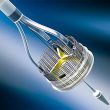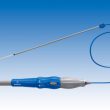Paravalvular leak is complication derived from incomplete sealing between the implanted prosthesis and the native annulus, which occurs in 5% of all patients who undergo mitral valve replacement and 10% of those who undergo transcatheter aortic valve replacement. This is the most frequent non-structural valve dysfunction. While mild leaks can be asymptomatic, moderate to severe<a href="https://solaci.org/en/2017/10/12/transcatheter-reduction-or-surgery-for-paravalvular-leak-repair/" title="Read more" >...</a>
How to standardize frailty in aortic stenosis patients
Frailty is the patient’s diminished capacity to recover after pathological or iatrogenic processes. It has a fundamental role when considering valve replacement, be it surgical (SAVR) or transcatheter (TAVR). This was clearly observed in the PARTNER I and Core-Valve Pivotal trials, which showed that despite a 95% technical success, 2 in 5 patients showed poor quality<a href="https://solaci.org/en/2017/08/16/how-to-standardize-frailty-in-aortic-stenosis-patients/" title="Read more" >...</a>
How can we classify aortic stenosis in patients who underwent TAVR?
Courtesy of Dr. Carlos Fava. Aortic stenosis can present different hemodynamic patterns, such as low flow and low gradient with reduced or preserved ventricular function. However, evidence on the evolution of different hemodynamic patterns after transcatheter aortic valve replacement (TAVR) is limited. This study consisted in a retrospective analysis of 368 patients who underwent TAVR. The population was divided in<a href="https://solaci.org/en/2017/07/26/how-can-we-classify-aortic-stenosis-in-patients-who-underwent-tavr/" title="Read more" >...</a>
Lotus Valve performance related to pacemaker implantation in patients after TAVR
Courtesy of Dr. Agustín Vecchia. Paravalvular leak was once considered the greatest disadvantage of TAVR when compared to conventional surgery. Nowadays, new devices and more-experienced operators have managed to “control” this phenomenon, keeping related statistics within acceptable ranges. Repositionable-valve Lotus may probably offer the most effective solution for this event; however, it is associated with high rates of<a href="https://solaci.org/en/2017/07/19/lotus-valve-performance-related-to-pacemaker-implantation-in-patients-after-tavr/" title="Read more" >...</a>
Transcatheter valve replacement in the bicuspid valve is increasingly performed, but challenges remain
As experience increases, transcatheter aortic valve replacement (TAVR) has expanded to different populations and anatomies. This study sought to compare technical and clinical outcomes in patients with bicuspid versus tricuspid aortic stenosis from the Bicuspid AS TAVR Multicenter Registry. Outcomes of 561 patients with bicuspid valves and 4546 patients with tricuspid valves were compared. Propensity score matching was used<a href="https://solaci.org/en/2017/07/05/transcatheter-valve-replacement-in-the-bicuspid-valve-is-increasingly-performed-but-challenges-remain/" title="Read more" >...</a>
Incidence, characteristics, and treatment of valve thrombosis after TAVR
Certain studies have carried out a tomographic follow-up of patients who underwent transcatheter aortic valve replacement (TAVR) and described the frequency of leaflet thrombosis; however, in most cases, it is unclear whether this finding requires some sort of intervention. The difference between this work and those previously published is that this study is not focused on imaging, it<a href="https://solaci.org/en/2017/06/28/incidence-characteristics-and-treatment-of-valve-thrombosis-after-tavr/" title="Read more" >...</a>
TAVR presents less post-procedural MI than surgical aortic valve replacement
Courtesy of Dr. Carlos Fava. Surgical aortic valve replacement (SAVR) continues to be elective, but the presence of post-procedural acute myocardial infarction (AMI) has been associated to bad evolution. Despite the proven benefits of TAVR for high risk patients and the progress shown by patients of intermediate risk, the incidence of post implantation MI has<a href="https://solaci.org/en/2017/06/13/tavr-presents-less-post-procedural-mi-than-surgical-aortic-valve-replacement/" title="Read more" >...</a>
Moderate Aortic Stenosis and Ventricular Dysfunction: Should Valve Replacement Come Sooner?
Ventricular dysfunction and moderate aortic stenosis are more frequent with advancing age and often coexist. Afterload reduction is one of the main pillars of pharmacological treatment of heart failure, and aortic stenosis (even that of moderate severity) increases the afterload. Nowadays, aortic valve replacement is only formally indicated for symptomatic severe aortic stenosis. This<a href="https://solaci.org/en/2017/05/25/moderate-aortic-stenosis-and-ventricular-dysfunction-should-valve-replacement-come-sooner/" title="Read more" >...</a>
REPRISE III: Lotus and CoreValve Compared in High-Risk or Inoperable Patients
The efficacy of transcatheter aortic valve replacement (TAVR) has been well-established. However, its limitations include suboptimal deployment and paravalvular leak. The Lotus system is a fully repositionable and retrievable device with controlled mechanical expansion. It features an adaptive seal to minimize paravalvular leak, it does not require early pacing during deployment, and, given its early<a href="https://solaci.org/en/2017/05/23/reprise-iii-lotus-and-corevalve-compared-in-high-risk-or-inoperable-patients/" title="Read more" >...</a>
TAVR in Intermediate-Risk Patients: Is It as Effective as Surgical Aortic Valve Replacement?
Courtesy of Dr. Carlos Fava. Transcatheter aortic valve replacement (TAVR) has proven to be beneficial for extreme- and high-risk patients. It is also increasingly used in intermediate-risk patients, and it has been hinted at for low-risk patients. However, different sectors in the medical community still challenge the existence of real TAVR benefit. This assessment consisted<a href="https://solaci.org/en/2017/05/03/tavr-in-intermediate-risk-patients-is-it-as-effective-as-surgical-aortic-valve-replacement/" title="Read more" >...</a>









